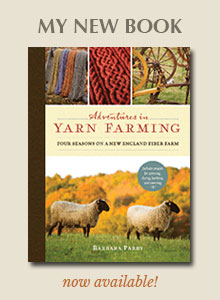Our Rhinebeck homecoming just happened to coincide with the first decent stretch of dry weather in nearly four weeks. While Mike and I unpacked the van, Norm wended his way through the fields cutting large swaths in the dense grass with his Kuhn mower. Clear skies and a light dew fall Monday night made for excellent drying time on Tuesday, perfect for tedding and raking. Then we let the breeze do its work, rustling through the windrows. When the windrows change color from bright green to dusty blue, it's time to run the baler.
Norm baled the upper end of the high mowing where the grass always dries fastest on Wednesday afternoon. That left the lower end of the high mowing and the big field directly across from the studio for Thursday. Boy, did we hustle to get it all in the barn.
Towed behind the baler, the "buncher" collects the bales. When it's full, Norm reaches behind the tractor to pull the string that pops the spring loaded gate at the back end of the buncher. It deposits a tidy pile of squares. We still have to go around, retrieve them by hand to load the wagon, but at least they're gathered in groups (more or less) rather than spread willy-nilly throughout the field.
Even so, there's tons of walking.
And lifting and stacking. We had many, many loads in the small truck. It's stake bed only handles loads of 50 or so bales. Since it's the only wagon narrow enough to squeeze down the aisle of the open barn, we made do.
If you're stacking the wagon, you stand on the empty deck. Everyone pitches bales onto the truck. They're coming at you, left, right, sideways. You stack as fast as you can, since there's many tossers but generally only one stacker. But then you end up on top of the load when the truck is full. Which means you get to toss down the bales at everyone else inside the barn. And they get to stack them. We took turns throwing square bales at each other all afternoon for two days.
Fred is the expert when it comes to backing the wagon through the gate and down the narrow aisle of the barn, without clipping a gate post or losing a mirror.
For Crackerjack and the boys, haying is a spectator sport for their dining pleasure and entertainment. They lounged in the afternoon sun while we bustled back and forth from field to barn.
As daylight exited, we gathered the last wagon load. I began tending to the sheep while Mike, Norm and the gang stacked the last bales in the barn, close to 760 total. We then raced around picking up broken bales and "sinkers" out in the field by the light of the tractor.
Relief doesn't quite cover the way I feel about finally having all my barns stashed for winter. We've never had a wetter summer nor a more fickle autumn for making hay. I've been worried that we'd have to go "shopping" – unimaginably expensive with a flock the size of mine. Farming sustainably means balancing the size of a herd with the capacity of the land to feed the herd – in all seasons. It looks like we'll squeak by.
Amen.
I promise to post some shots of Rhinebeck, once I've caught my breath.




